Honor Launches The View20: A 48MP Camera Review
by Andrei Frumusanu on January 28, 2019 8:00 AM EST- Posted in
- Smartphones
- Mobile
- Kirin 980
- Honor View20
System Performance
System performance of the Honor View20 shouldn’t bring any big surprises because it contains the same Kirin 980 chipset as we’ve reviewed in the Huawei Mate 20 and Mate 20 Pro. The chip performed excellently in those devices, and there isn’t any reason for the View20 to perform any different.
Honor employs the same kind of “Performance” mode in the View20 as we saw in the recent Huawei flagships. This performance mode is found in the battery settings of the device. The mode is a bit confusing for new users as it represents a new setting that previously wasn’t present on Huawei devices. Following our articles about Huawei/Honor cheating in benchmarks last year, the company had decided to implement this new “full intended performance” mode, while by default the phones would come in a more limited state.
The difference between the normal mode and the performance mode, as far as I have been able to tell, is the scheduler and DVFS ramping behaviour, as well as possibly thermal limits. The performance mode is in technical terms very much similar in behaviour and scaling speed as recent Qualcomm Snapdragon SoCs in competing devices, while the normal mode is a more conservative mode which is about twice as slow in its ramp up speed.
What I did note was new in the View20 is there’s actually a battery warning in performance mode. I’m not sure exactly why this was implemented as we’ll see in the battery life results page, it’s absolutely not something to worry about.
In general, I recommend performance conscious users to have performance mode turned on, while people who are less sensitive and do not notice the difference it might be worth to stay in normal mode and enjoy the slightly better battery efficiency.
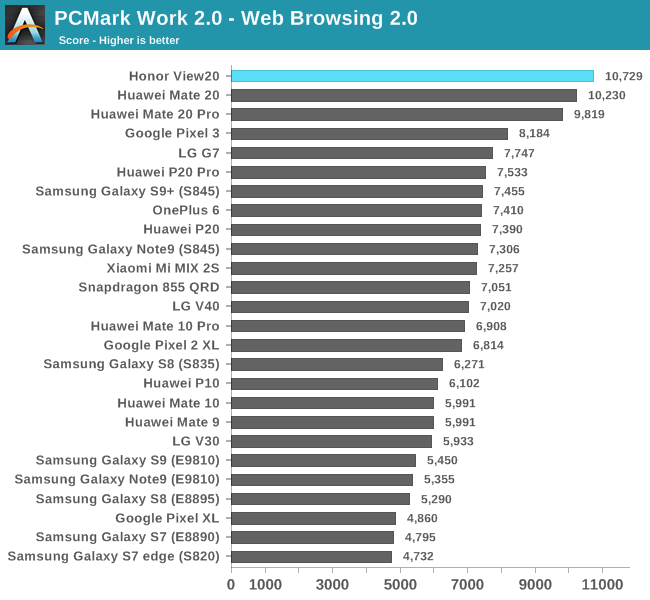

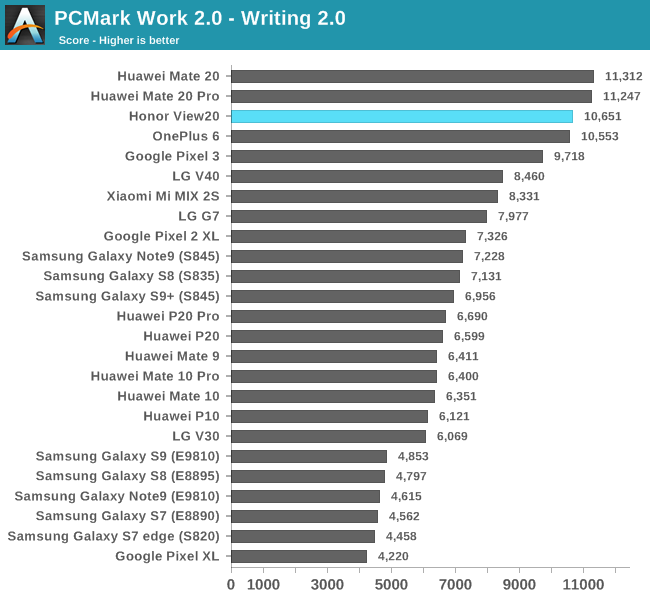
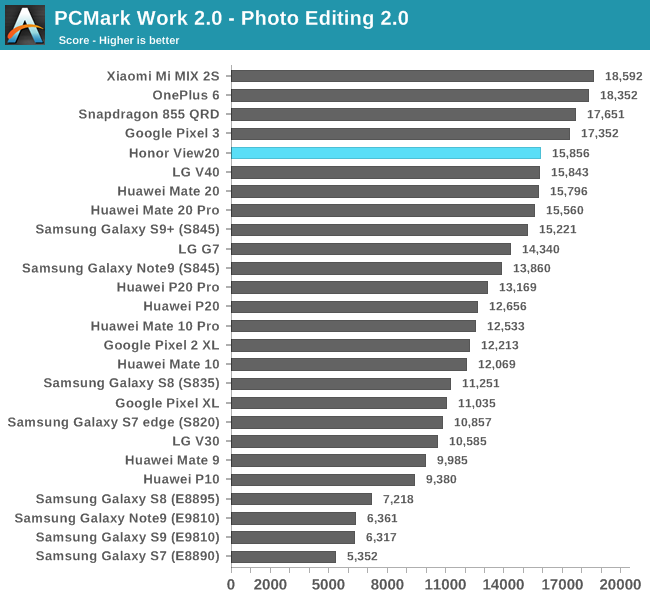
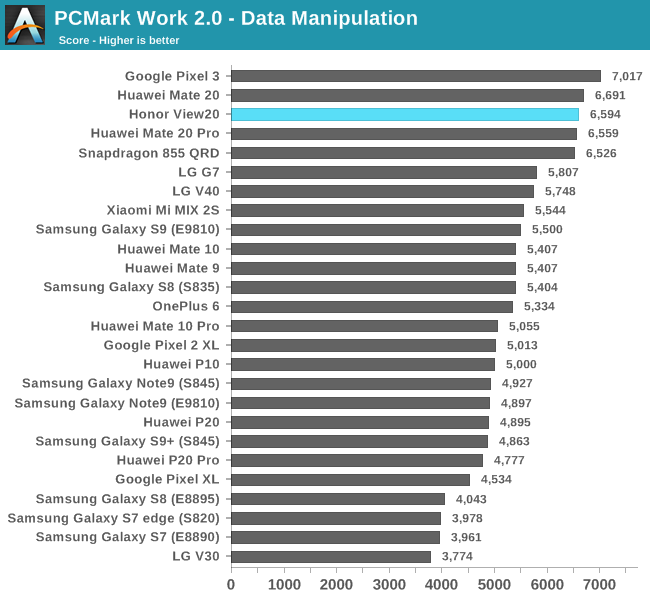

In PCMark, the View20 performs within margins of error the same as the Mate 20’s – which again was to be expected.
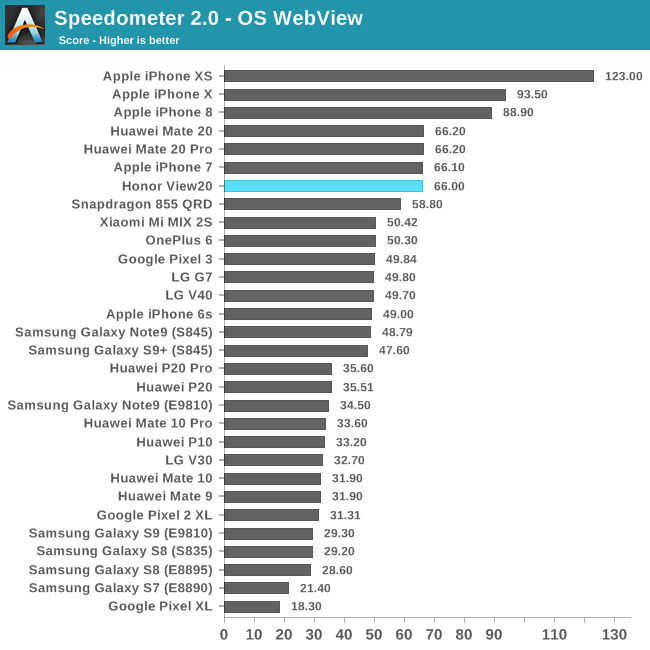
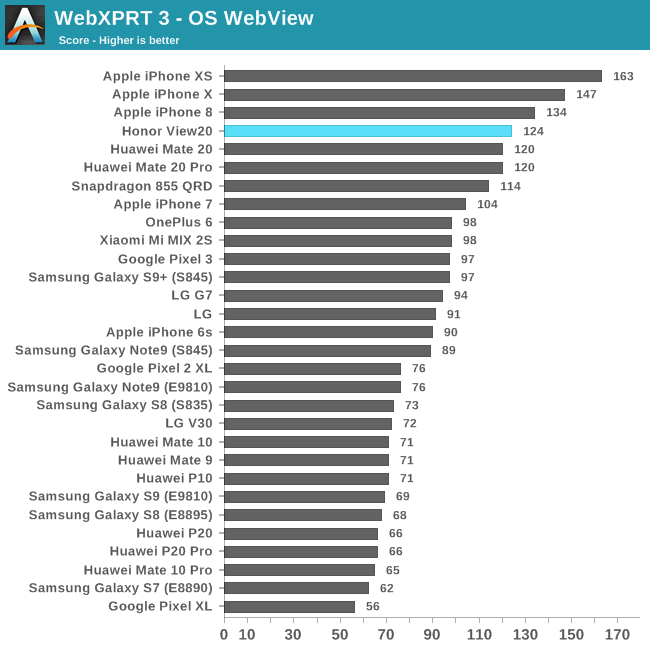
In the web benchmarks, the View20 performs either equally well as the Mate 20’s, or in WebXPRT, actually slightly beats the Huawei flagships by a small amount.
Overall the performance of the View20 is very much at a flagship level and is at the very best of what you can get out of an Android device nowadays. Since our review of the Mate 20’s, we have been able to get preview performance figures of the new Snapdragon 855, and in terms of system performance, the Kirin 980 chipset devices are more than able to compete with Qualcomm’s new flagship. This means that for the rest of 2019, it looks like devices such as the Mate 20 and in this case the View20 will be among the top performing devices that you can get, which does bode extremely well for longevity of the phones.










37 Comments
View All Comments
apphil - Monday, January 28, 2019 - link
One thing I am extremely curious is the performance of the GPS chip as it is one of the first phones with L5 GPS and this should increase accuracy a lot. Can you guys comment on that or maybe test that, as better navigation and positioning would be a very interesting feature for me.Andrei Frumusanu - Monday, January 28, 2019 - link
One of the benefits of this was in more urban areas with tall buildings, unfortunately I wasn't able to actually test this out. The phone's location APIs also does not disclose whether it sees L5 satellites or not - usually you see it when there's a duplicate ID, however this does not appear on the View20.808Hilo - Monday, January 28, 2019 - link
The cam is disappointing. Can we just have a big sensor and a manual lensring of my choice and 4k or 8k raw at 30fs the back. NOW!!!Its not difficult. Just do it. Nikon in my case. I got a nice selection of 8-50mm lenses and dont want yours.
Engineering a phone is not difficult. Adding a lensring and a big sensor is a breeze.
Valantar - Monday, January 28, 2019 - link
Difficult? Not if you don't care about size, no. The flange distance of the Nikon Z-mount is 16mm, for their F-mount it's 46.5mm. Add a handful of mm to that for the display, and 10 or so for the sensor and shutter array - more if you want IS. That's a chunky phone, even with a Z-mount. And constructing lenses for shorter flange distances with large sensors is _extremely_ difficult, as you'll have to correct for ever more distortions towards the outer parts of the sensor. Of course they could have spacer rings or similar to adapt lenses, but that would kind of defeat the point, no? You wouldn't be able to fit it in your pocket unless you're wearing MC Hammer pants. Also, 8k30 in a phone? At what bitrate, 50Mbps? For any bitrate worth the pixels in 8k, you'd need storage in the several-hundred-GB amounts for even a collection of short clips, and the processing power needed would require large interchangeable batteries - unless you want your phone to die after filming for 5 minutes? And good luck getting that video material off a phone with non-removable storage in a reasonable amount of time. I suppose you'd want it to have an SSD bay too?hanselltc - Monday, January 28, 2019 - link
>Engineering a phone is not difficultbuild ur own phone m8 :v
Manch - Monday, January 28, 2019 - link
TOF sensor would be great for 3D scanning! Why not have an app to take advantage!jabber - Monday, January 28, 2019 - link
You know I'd settle for a truly excellent 8MP main cam to be honest.Forget going mega megapixel. Just get the fundamentals right first.
shabby - Monday, January 28, 2019 - link
Nothing to do with megapixels in this case, the sensor is great, everyone uses sony sensors, its the isp and software that sucks. The isp on these chinese made soc's is way behind the snapdragon isp.Heck even sony doesn't know how to fully take advantage of its own sensor. The pixel 3 and pocophone use the same sensor and we all know which phone takes the best photo's.
Midwayman - Monday, January 28, 2019 - link
Yes. This. Especially with more phones putting on more than a single lens. I care way more about the quality of the pixels than the quantity of pixels. 48mp photos just take up more space if they are just a grainy mess in anything but the brightest light.jabber - Tuesday, January 29, 2019 - link
Exactly. They spend all the time fussing over the sensor and then throw out the lens/flash/focusing/software/compression/NR features.I bet the sensors from 4 years ago would beat most current flagships if they bothered to spend more than a weeks development on all the other fundamentals.